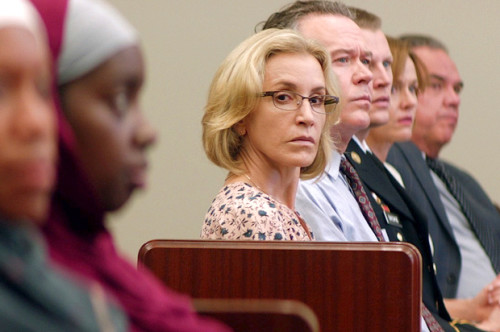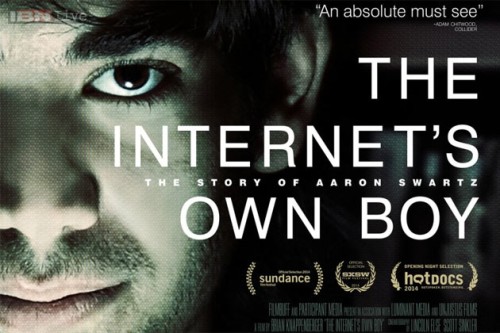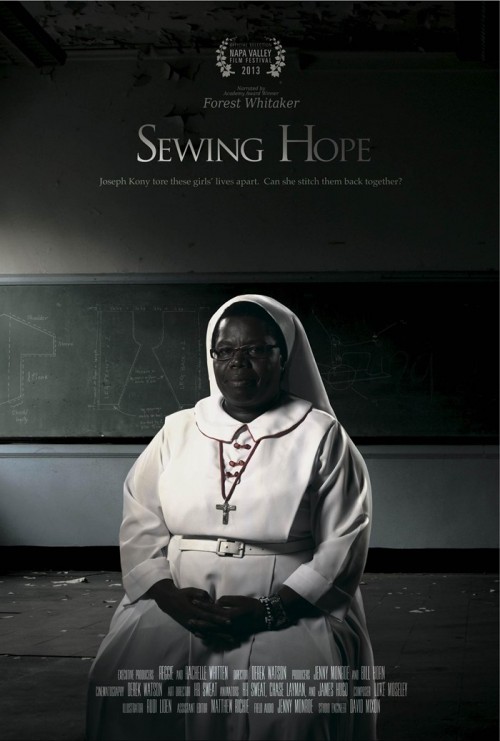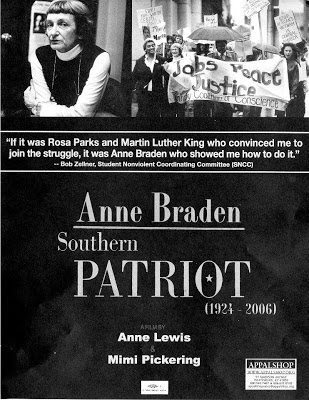This guest post by Sean Weaver appears as part of our theme week on Masculinity.
When I was a young preteen kid, my dad told me tales of how Miami Vice and Magnum, P.I. once helped him entertain the dream of becoming a private detective. He was so enamored by detectives and the law that he took a college course on crime, criminal investigation, and the law. Unbeknownst to him, I remember stumbling across one of his old tape recorders, hitting play, and listening to his own secret sting operation play out. Perhaps that’s where I began my long career of advocating social justice–justice against a system that is seriously flawed.
With all nostalgia and conspiracy theories aside, at first glance, Jonathan Ridley’s (director of 12 Years a Slave) American Crime seems like one of those old school detective thrillers, the likes of which have entertained American television and cinema since the 1980s. Up to its premiere on March 5, 2015, I had seen previews on ABC. I imagined it would be everything I had hoped in a detective drama: the gritty neo-noir tone, the masculine detective hero out to solve the un-solvable case, and the plot line driven by suspense and a nagging “Who dun it?” Instead, what I came across is a show that is powerfully poignant, thought-provoking, and one that delves the viewer deeper into the conditions of the human experience.
This isn’t a show aimed at entertaining. It is a show that relies on provoking the viewer into moving past that cushy comfort zone of self-identification, and questioning the very foundations that control our daily lives: social justice, race, and gender. In her review on American Crime in The New York Times, Alessandra Stanley beautifully captures the sentiment and driving force of this show. She states, “This series is at heart a murder mystery—someone has been killed, and the show withholds who did it. But solving the crime isn’t the point. The murder is a clue to the mysteries of character, experience, and self deception…”
It is a murder mystery. But, as Stanley so eloquently puts it, it isn’t. It’s so much more. In the introduction to her book Detecting Men: Masculinity and the Hollywood Detective, film critic Philippa Gates writes:
“The detective genre has traditionally been a male-centered one based on the social assumption that heroism, villainy, and violence are predominantly masculine characteristics. The detective genre has traditionally been a male-centered one based on the social assumption that heroism, villainy, and violence are predominantly masculine characteristics…Not only is the genre male-centered, it is also hero-centered, tending to adhere to a structure of binary oppositions— good/bad, civilized/uncivilized, law/crime, order/chaos, and heroes/villains…[However] Not all detective films make absolute distinctions between these oppositions, and the examination of the indeterminate, ‘gray’ area between heroism and anti-heroism also proves illuminating in terms of the social mores and attitudes toward crime and law that it can reveal.”
Gates rightly points that not all detective films, and in this case show, make absolute distinctions in these traditional masculine tropes/themes. American Crime focuses on illuminating this “gray” area that reveals the social mores and attitudes toward crime and law, and in turn attitudes on crime, race, and gender in American society. It forgoes the masculine detective hero out to solve the crime, and instead focuses on those impacted by such crimes—whether they are guilty by circumstance/hearsay, victims in their hurt, or even willing participants. Like Stanley also points out, this “gray” area exists in the things the characters fail to say or do. By focusing on this “gray” area, viewers can truly come to appreciate the complexities of this astounding show.
Set amidst the dark and drug-filled backdrop of San Modesto, California, the show centers primarily on four families and the suspects associated with a high profile murder, all poised to give into the collision course of hate, fear, and suspicion that guide their highly racialized and gendered lives. In short summary for those who haven’t yet seen American Crime, the driving plot is that a White man is killed by a Black man, under the guise of a “hate crime.” Hold on to that for a second. A Black man is charged with committing a hate crime against a White man. Talk about flipping the traditional binary. With that said, even the traditional gender binary is flipped on its head—the women of the show uphold the patriarchal system that controls them, while the men are often portrayed as effeminate and oppressed by the same system that is supposed to give them power. Yes. Take a second while you process that. And finally, each character is hell-bent on seeking a social justice, whatever that may be, that reasserts their own existence. I’d rather not give away to many more details. Take my word for it, watch it.
With all the background stuff out of the way, the task of unpacking the complex lived realities of the Skokie and Nix families is rather daunting. However, at the head of the Skokie family is Barbra Hanlon (Felicity Huffman), mother of the murdered White man, and ex wife of Russ Skokie (Timothy Hutton). Barb fits all the characteristics of the stereotypical suburban middle aged White woman. She is assertive, grieving, and every bit fearful of those she perceives as “other.” She is the walking parrot of the patriarchy, and embodies all its masculine ideals. She wields power, through her very own existence. So much so, that if you hadn’t watched the first few episodes, you would swear that she was the intended murdered victim.
She creates fact from the truths she is unable to face. She decries her son a hero, even after authorities question her son’s involvement in an illegal drug cartel: “You want me to say stuff about my son that isn’t true? He is a war hero, a veteran.” Finally she gives into the easy out of declaring racism and her son’s murder a hate crime, knowing that the lead suspect of her son’s murder is in a relationship with a White woman. She groups people by the stereotypes engrained in her social upbringing—even going as far as declaring, “It was probably one of those illegals.” At one point, she comes into her power and wields it, well, like a man—even going as far as purchasing a firearm. The feminist in me cringes at this description. Because on the surface it seems like the stereotype of the grieving hysterical mother is being perpetuated once again. But there comes a point in the show where the viewer realizes she is not just a woman facing “hysteria.” No, the show is pushing past the perceived identities we take so much stock in. Instead, it shows how easily it is for the oppressed to become the oppressors by wielding fear and distrust. It also shows how people often negotiate the power of their identities at the expense of others.
The antithesis to Barb’s masculine ideals is her ex-husband, Russ. Like his wife, Russ takes stock in illusions that the exterior just needs to be brushed off. Russ is the failed man. When I say failed man, I mean he fails to live up to the expectations of the patriarchal world that controls his life. He is weak, timid, and ultimately unable to hold ground with his wife. At one point Barb delivers the ultimate emasculation speech, concerning where and who should bury their dead son exclaiming, “You walked out. You no longer get to say you’re his father.” The viewer becomes perplexed and is left with figuring out whether she is right or wrong. Is he the hero because he has returned? Does he return to step into the perceived masculine role of putting the pieces back together? Does his masculinity rely on the perceived social norm that the man is the back bone of family? Has he really overcome his gambling addiction? For Russ, the answer is yes, because countless times he declares, “We need to be a family.” In the end, Russ can only reclaim his own lost masculinity by taking his own sense of justice. In the final episode, Barb is distraught that the man she deems murdered her son is released. Her masculine veneer fades, and the viewer is left with a defeated woman realizing the realities she has fabricated are nothing but lies. After being cast off by Barb in a moment of rare intimacy between the two, Russ returns home to the gun that Barb has entrusted in his care. She has rejected his last attempt to once again reunite the family, his last attempt to be a man. He fails to be the hero, and instead becomes the villain he has tried to protect his family from by murdering Carter Nix (Elvis Nolasco).
On the receiving end of the prosecution is the Nix family. Carter Nix stands accused for the murder of Matthew Skokie. While the show never reveals whether or not Carter killed Skokie (which to me is a nod to the infamous system in which the guilty go free and the innocent accused), the viewer is left to come to their own conclusion. The facts are plentiful, but the truth is even harder to discern, and is found only in what is left unsaid. On the surface, it might seem like the show is reproducing the Black “thug” stereotype; Carter is a drug addict dating a White woman with the same problem. In fact, every chance they get the prosecution tries to save Carter’s girlfriend Aubry (Caitlin Gerard) from the menacing Black man: “Give us something to put him away.” However, Carter is far from the stereotypes that seem to define his life, and consequently his actions. Like his White counterpart Russ Skokie, Carter is a defeated man, emasculated in every sense of the word. While the circumstances differ, the same power structure is at play. The reason Carter relies on drugs is to create realities he wishes to see as truth. In one scene, Carter discusses how Aubry has saved his life with his sister Aliyah Shadeed (Regina King). He states he was miserable being an accountant, subservient to the White men that controlled his life. He then shares with her a magazine clipping of a Black man and White woman, the reality he wishes to share with Aubry, but cannot due to the interference of what is socially acceptable and not. He must negotiate his identity for drugs, and perceived lived realities, all while fighting an impenetrable system of control.
Finally the last person who seems to take a central role in the unfolding drama is Aliyah, Carter’s sister. She is every bit the counterpart to Barb Skokie. In fact, she is just as strong and willfully powered. She becomes the spearhead of a campaign to free Carter and is right to point the finger at a system that is massively corrupt. In one brilliant dialogue with Carter she states, “You sleep with their women, use their drugs, and take their guns. And you don’t expect to be locked up here?” She is a strong figure and is masculine in her own rights. However, in her fight to free Carter from his metaphorical chains she becomes just as guilty of upholding and instilling fear and hate. Like Barb, she becomes the victim; it is no longer her brother’s fight. In doing so, she manages to push Carter into breaking up with Aubry, forcing Carter to take sides in an invisible war. Just before the final scene in which her brother is murdered, Aliyah gives a speech in her mosque stating, “If we as a people cannot forgive, then we are cursed to hate.” The irony is that Aliyah was only able to forgive once her cause had been won. But her victory comes at the cost of her own negotiated identity, proving that the true American crime is not the physical act of murder itself, but something far more harmful: the negotiation and deception of one’s self.
Sean Weaver has a MA in English/Literature from Kutztown University. He is currently News Editor at Vada, an online magazine from the UK with a new queer perspective. When he isn’t reading or writing, he is hard at work looking for new ways to understand what it means to be queer.
Twitter: @levirush8
Blog: http://post-colonial-scholar.blogspot.com



















